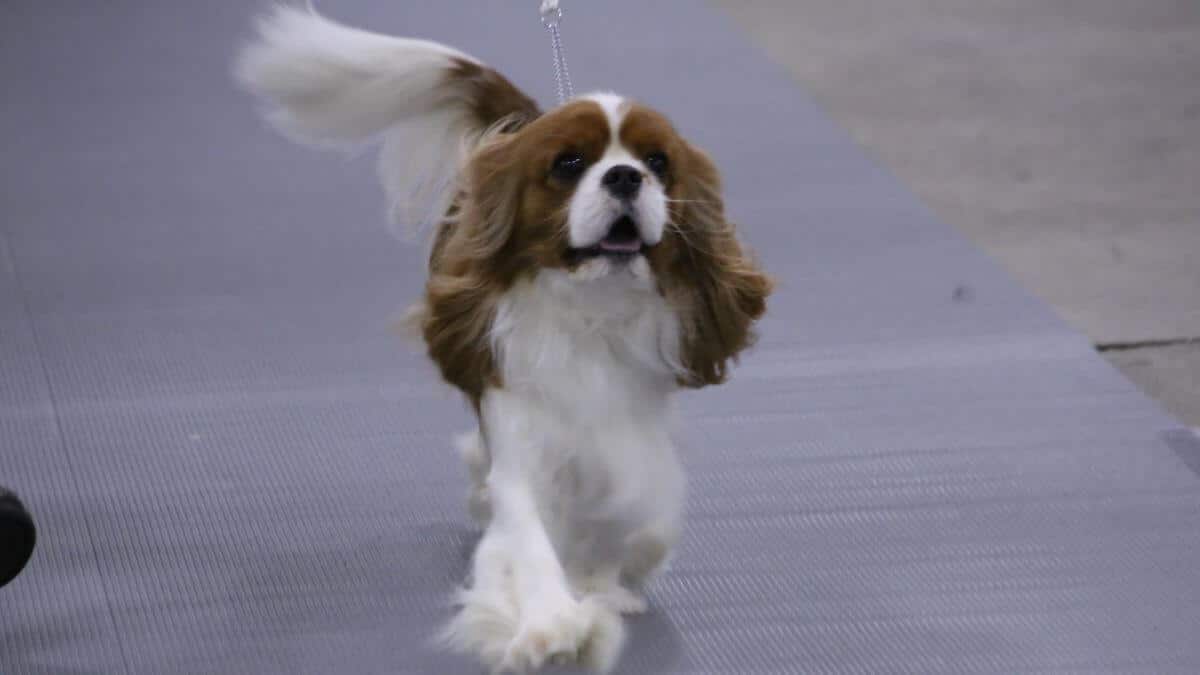


Home » A Judge’s Point of View

This article was originally published in Showsight Magazine, October 2015 issue.
I am a judge for both the American Kennel Club and the original Cavalier King Charles Spaniel Club USA, known as the “Old Club.” I have judged Cavaliers all over the world for many years.
I have been a breeder of Cavaliers for 20 years. I am the breeder/handler of the current #1 Cavalier in the American Kennel Club and have finished over 100 Champions, 26 from the BBE class.
However, for this article, I am removing my breeder/exhibitor hat and will don my judge hat. I will touch on issues that exhibitors and judges of Cavaliers should seriously take to heart.
The numbers of CKCS are increasing in this country at an alarming rate, as predicted by both the National Parent Club and the “Old Club” when the breed was removed from the Miscellaneous Class and admitted to the Toy Group.
Cavalier rescue, which had very little work before AKC recognition, is now bursting at the seams. This charming and loving little breed, once a well-kept secret, has been discovered and is being bred in alarming numbers by many puppy mills and uneducated backyard breeders.
When Cavaliers were first admitted to the Toy Group, entries of 2-5 were normal. The numbers have climbed considerably, with an average of 25 per show, many of which are in the BOB class.
Judges often predict, by the winning ribbons they hand out, who will be used for breeding. For this reason, it is critical that the Parent Club continues to educate judges, something they have fallen behind on.
As a judge, I never receive reminder letters—like I do from other breeds I judge—on what is expected regarding how CKCS should be shown and moved, and addressing reminders on trimming, which is out of control in this country.
Just being approved to judge Cavaliers does not make someone a good judge of the breed. In the beginning, Cavaliers were a “filler” breed needed for judges to advance through a group. Today, Cavaliers are a principal, big-numbers breed, often the largest Toy entry at a show.
Many judges have no clue what makes a quality Cavalier. Some think they should be dripping in coat, which is not true. Coat should be moderate, as excessive coat is often used to hide faults.
There are critical issues relating to judging and showing the Cavalier King Charles Spaniel, and I will touch upon a few.
A common judging mistake is allowing exhibitors to race Cavaliers around the ring, with handlers loping like antelopes, and further allowing handlers to hand-stack on the ground. This is not how the Cavalier is to be shown, according to the Parent Club. Years ago, letters were sent to judges reminding them of this.
The Cavalier is a natural breed and does not need to be stacked like a statue. At the Old Club monthly shows, which have entries comparable to AKC Specialties and only allow professional handlers to show dogs they own or co-own, no one runs or gets on the ground.
If a judge or prospective judge wants to learn and cannot attend a National Specialty or at least a specialty, they should attend an Old Club show. Mentors are available at these events, and the quality of the dogs is high. I often hear judges discussing dogs during lunch or at the Group rings.
They say things like, “that Cavalier is too big or does not have enough coat.” Very uneducated statements! What is TOO BIG? What is not enough coat?
Some CKCS are at the top of the standard, 13 inches. The standard is very loose on height, as it states that slightly bigger or smaller is acceptable. Well, that leaves it to the judge, and I have rarely seen a Cavalier that is too big.
In the UK, most of the top males are larger. They don’t care and feel that if a dog is in balance with the proper head, it is correct. You never hear a judge saying, “That Cavalier is too small.” 12 inches is the bottom, and slightly smaller is okay. Yes, it’s a Toy breed, but the biggest of the Toys.
If a 13-inch dog is standing next to a 12-inch dog, the 13-inch CKCS will look giant! One inch makes a BIG difference, and judges need to get a handle on this before they step in the ring to officiate. If the dog is balanced and within standard and looks correct, that is all that matters with size.
Most top-winning males weigh 1-3 pounds OVER the 18 pounds the top of the standard calls for, because of good bone and body, most certainly not because they are too big. Of the top 25 Cavaliers currently being shown in the USA, NONE are over 13 inches. In fact, most are in the 12.5-inch range, but many weigh more than 18 pounds.
CKCS has enough coat if ears, tail, and leg feathers are long. Correct body coat is moderate, not long!
Much more serious is bad structure. Short necks and bad shoulders go hand in hand and are a problem in Cavaliers at this time. The short-necked dogs are quite often longer with shorter legs and often have a topline that is not level.
Tails up in the air above topline more than 1-3 inches or curled gaily over the back are being rewarded by some judges. This is as serious a fault as white in the eye, with the worst being a ring of white or eyes that are not ROUND and dark.
Lots of almond eye shapes are showing up—VERY faulty! The eyes are so important in the Cavalier, as they give the soft expression the breed is known for.
I have had other judges ask me how to know if a face is correct. I feel if you look at any Cavalier face and your heart skips a beat and you feel like saying “awwwwwwww,” with no questions, then I find it correct.
The dogs that win are normally bred, which is the reason we are seeing so many inferior Cavaliers in the ring today. The correct dog/bitch often looks different from most of the entries. Judges rarely have the courage or knowledge to withhold a ribbon.
The dog that has a ribbon withheld today can win the next day. The owner of the dog, of course, says the judge who withheld is an idiot, but big applause to the judge who withheld. Good breeders consider you as the best for our breed.
At a National Specialty several years ago, an entire class of bitches (9) had ALL RIBBONS withheld. That took guts! As a judge, I would not hesitate to withhold a ribbon to keep an inferior exhibit out of my Winners class. I personally have given a third-place ribbon to a class of one.
That dog may well be a Champion today, but not with my name on record as rewarding it.
Grooming and cleanliness are of the utmost importance to a judge. Yellow hair, that according to the CKCS standard should be pearly white; dirty teeth or eyes, long nails, and not freshly bathed are turn-offs to judges. What should be more of a turn-off are TRIMMED coats, mostly ears, backs, and feet!
I am the first to acknowledge that CKCS are “neatened,” however, it’s the PRO handlers who started trimming ears and top lines, etc. Worse yet are the judges who are rewarding these exhibits when the standard clearly says they should not be in the ribbons!
Cavalier ears do not grow round (the same look as the totally shaped ears of the Cocker Spaniel). Yet, the top handlers of Cavaliers have perfect rounded bell ears, all layered to be fat and full. Very cute indeed, and totally incorrect!
Dips in top lines are the handler specialty, as they use thinning scissors to cut in above and below to level it out for appearance. However, you can still FEEL IT!
Most of the winning Cavaliers that have a bad rear assembly (cow hocks, etc.) grow the hair very long on the rear to hide it from most judges, but you can still FEEL IT and see how the pads come up as they move away.
Sad that some judges only judge by what they see visually and have no clue about these faults when examining on the table.
It is a great sport and one that I have been in since I was a child. I read a book just before I showed my first dog, by Virginia Nichols, 50 years ago, titled How to Show Your Own Dog, which is most likely out of print, but that book taught me so much, even how to use and say the word “bitch” correctly without cringing.
From the judge’s point of view to exhibitors, we are very forgiving of novice handlers showing their own dogs. Don’t be afraid to show your own dog. It is okay to make mistakes—that is very normal and how we all learn. Just as many owners have put Championships on their dogs as professional handlers.
From the judge’s point of view to judges, when you look at Cavaliers and your heart hopefully skips a beat, let’s make sure you are perpetuating this beautiful dog for correctness.